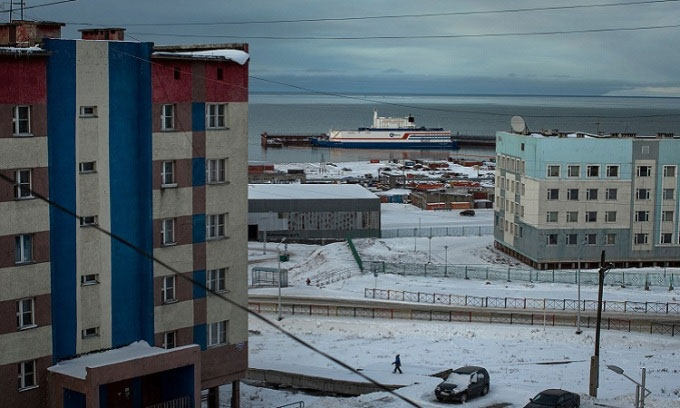A town in Siberia is testing a direct nuclear heating system powered by a mini nuclear plant installed on a barge.
While countries around the world are participating in a summit in Scotland to seek new solutions to mitigate the impacts of climate change, Russia sees the nuclear heating system in Pevek, Siberia, as a potential solution. Countries like the United States, China, and France are also considering building similar small reactors.

The floating nuclear power plant docked in the port town of Pevek in the Arctic. (Photo: Emile Ducke)
Jacopo Buongiorno, a professor of nuclear science and engineering at the Massachusetts Institute of Technology, commented that this is an intriguing idea. Small reactors can warm greenhouse gases or provide heat for industrial purposes. According to him, Russia is at the forefront of this new approach.
Nuclear heating systems in residential areas differ from electric water heaters powered by nuclear energy. Direct nuclear heating systems, which have been tested in small areas in Russia and Sweden, circulate water between the power plant and homes, transmitting heat directly from fissioning uranium atoms to residential areas.
Heating homes with nuclear energy also has numerous environmental benefits. Essentially, this method helps avoid wasting heat that typically escapes as steam through the cooling towers of nuclear plants. Instead, it is used to heat residential areas.
However, some experts remain concerned about the potential risks, citing numerous oil spills and accidents involving submarines and icebreakers from the Soviet Union and Russia when using similar small reactors. For instance, nuclear submarines sank in 1989 and 2000.
Buongiorno noted that the experiment in Siberia could play a crucial role in persuading countries to adopt nuclear energy to combat climate change, not only in electricity production but also in many other sectors.
Russia has a long history of using nuclear technology for civilian applications that have not yet been accepted elsewhere. The Soviet Union once considered detonating atomic bombs to mine open-pit mines and dig irrigation canals. Regarding icebreakers, Russia operates the world’s only civilian fleet powered by nuclear energy. In some locations during the Soviet era, engineers connected a reactor intended for plutonium production for bombs to nearby homes for heating. These reactors continued to operate in this manner for many years, even when there was no need to manufacture weapons.
The nuclear facility in Pevek is located on the Akademik Lomonosov, a barge the size of a city block. The idea of small reactors is not new. In the 1960s, this was considered a promising technology. The United States operated a barge-mounted reactor to electrify the Panama Canal region from 1968 to 1976. Sweden also utilized a nuclear heating system in the suburbs of Stockholm from 1963 to 1974.
In Pevek, the town’s community sauna will soon operate on nuclear energy. The Russian nuclear company, Rosatom, connected the reactors to the heating pipes in a neighborhood in June 2020. The company is currently expanding hot water services throughout the town, which has a population of about 4,500. The two cores of the plant are cooled by a series of water loops. In each reactor, the first water loop becomes contaminated with radioactive particles. However, this water never leaves the plant. Through a heat exchanger, it transfers heat, but without carrying contaminated water, to other loops. In Pevek, one of these loops is the pipeline that leaves the plant, branching off to provide hot water to households.
Rosatom emphasizes several safety features of the system. The mini nuclear plant can withstand the impact of a small aircraft. Water circulates through the buildings at a higher pressure than in the cooling loops, helping to prevent radiation leaks into the town.


















































